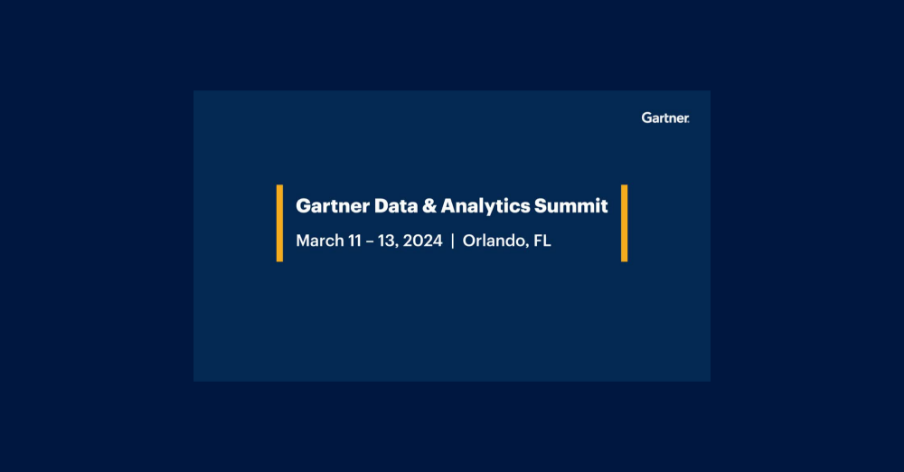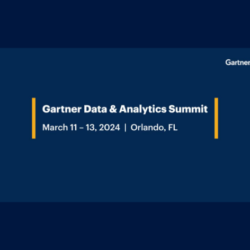 Reading Time: < 1 minute
Reading Time: < 1 minuteThe 2023 Gartner Data & Analytics summit at Orlando, Florida just concluded and like every year, there was so much to see, learn and discuss with my fellow data nerds.
The Gartner D&A summit always presents a remarkable synthesis of what’s happening in the data and analytics world and how organizations need to consider new perspectives in D&A and design better decisions in a world of perpetual change. With this year’s theme of ‘‘Lead for Purpose. Connect with Trust. Make an impact.”, the writing on the wall was clear: CDAOs need to purposefully lead their team by balancing trust, accountability, governance, and security with adaptability and responsiveness to ensure the success of their data-driven transformations.
The tone of the conference was set with the opening Keynote by Rita Sallam & Kurt Schlegel, who made it pretty clear from the start that given the significant growth of data and analytics in any organization, its more important than ever before for D&A leaders to remember that “with great power comes great responsibility”. This translates to actionable plans at three main levels.
- At an organization level, this entails aligning your D&A strategy to the overall organization’s critical priorities, which means working on not just delivering results but building value stories that speak the language of business and having mechanisms to measure both direct and indirect financial value.
- At a team level, this translates into everyone working on the ‘common’ D&A vision with focus on understanding the ‘why’. What is critical is to always keep the knowledge worker’s motivation at the center, tapping into the intrinsic motivation and building unconventional choices in talent strategy.
- Finally at a personal level it means achieving a balance of head, heart, and self-awareness to ensure you are making important decisions that move the organization forward.
For Fosfor, this message was music to my ears. It not only validated our vision of harnessing the true power of data but also reiterate the belief in infusing data and analytics within an organization’s DNA. Along these lines, here are my key takeaways from the summit:
- Operationalizing AI remains a big challenge. In one of the sessions Gartner shared that “Only 10% of organizations can reliably get machine learning models into production”. The convergence of MLops and ML engineering make it easier to set up the post-model-creation processes for success. With Refract, our focus has been to bring ML engineering and MLOps together. The guiding principle and target is to create a seamless experience post the model experimentation & model development processes and our roadmap is aligned to fulfil these requirements.
- Analytics needs to move into action. Business value needs to be central to any D&A strategy. A lot of discussion during the summit was on the importance of first principles. The goal is to create a business strategy that is infused with data and analytics, not a data strategy or an analytics strategy. At Fosfor, our focus on business use cases and vertical solutions to cater to different business and analytics personas is well established.
- Generative AI will evolve quickly. If the early success of ChatGPT teaches us anything, it’s the power of fundamental models and the significant change they bring to anything they touch. The enterprise natural language technologies will continue to grow and create strategic differentiation avenues. Lumin’s own language model will grow exponentially as we bring in GPT and make language central to all user experience.
- Decision Intelligence moves into high gear. According to Gartner, the success of an organization is nothing but the sum of all its decisions. During Lumin’s Showfloor Showdown session on Day three, I highlighted that insights are central to all organizations and the genesis of insights is the curious mind. Organizations will increasingly seek to enable their business users to undertake the insight exploration journey with ease, which will help them augment their decision making.
Gartner also predicted that by 2026 75% of the global Fortune 500 companies will apply decision intelligence to their processes. There was also a general consensus that there is never one single way to solve a problem and that great questions beat great analysis (or data). Businesses will optimize decisions by making them more continuous through decision support/ decision augmentation or decision automation tools and platforms.
It’s clear from the summit that the data and analytics practice is becoming pivotal to any organization and as a Product suite in the data to insights value chain Fosfor’s product roadmap across all three products–Spectra, Refract, and Lumin—is aligned with where the industry is heading.
I can’t wait to see how the generative AI space will evolve and how far we’ll have progressed when next year’s D&A summit rolls around!
 Reading Time: < 1 minute
Reading Time: < 1 minute







